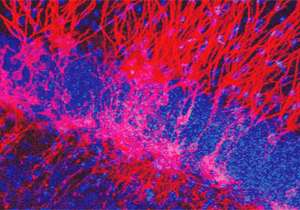Understanding the chemical mechanism behind antidepressants

(Medical Xpress)—Millions of Americans take antidepressants such as Prozac, Effexor, and Paxil, but the explanations for how they work never satisfied René Hen, a professor of psychiatry, neuroscience and pharmacology.
So the French-born researcher began a series of experiments a decade ago that are now helping to overturn conventional wisdom about the class of antidepressants known as selective serotonin reuptake inhibitors (SSRIs) and providing new insights into the biological mechanisms in the brain that affect mood and cognition.
SSRIs, it has long been thought, work by inhibiting brain cells from reabsorbing serotonin, a signaling agent in the brain associated with positive mood. Yet unlike with psychoactive substances, the effects of the drugs take weeks to be felt—even though the increase in serotonin circulating in the brain begins almost immediately. Something more, Hen concluded, must be happening after that to create such a profound effect in depressed patients.
In 2003, Hen demonstrated an important finding in mice: The change in mood—measured by the amount of time it took the animals to overcome anxiety and feed in new environments—appeared to be due in part to the production of new brain cells in the hippocampus, an area of the brain associated with learning and memory. And those new brain cells, Hen thinks, are the result of growth-stimulating chemicals released in the brain, in response to the increased serotonin.
Last year, Hen published another groundbreaking study, suggesting how these new brain cells might affect mood. The new brain cells are located in the dentate gyrus, an area of the hippocampus involved in pattern separation, a cognitive process that helps us to recognize that something is new and different from similar experiences and stimuli. This information is then sent to other brain regions where the new stimulus is assigned a positive or negative emotional value.
Using genetic manipulations that block or enhance the production of brain cells in the dentate gyrus, Hen demonstrated that the new brain cells led to a marked improvement not just in the cognitive abilities of mice, but also in their mood. "What we think, even though it hasn't been proven yet, is that some depressed human patients also have a problem with pattern separation," Hen says. "What we are hoping is, if we can boost production of new neurons in their hippocampus, maybe we can improve pattern separation in patients and decrease general symptoms."
Hen sees numerous ways that a disruption in pattern separation might lead to negative emotions such as anxiety and depression. The hippocampus is located next to, and is strongly linked with, another brain structure, the almond-shaped amygdala, thought to be the seat of our emotions.
If wrong judgments were assigned to novel stimuli in the amygdala, that could easily trigger the brain's fight-or-flight instinct or, at the very least, produce fear. That might help explain features of anxiety disorders—why survivors of the 9/11 terrorist attacks suffering from post-traumatic stress disorder, for instance, might be hit with a panic attack whenever they see an airplane fly over a skyscraper, Hen says.
A deficit in pattern separation might also help explain why depressed patients often are unable to experience pleasure, exhibit a lack of interest in novel experiences, and feel profound malaise. Perhaps they are simply unable to register an experience as novel or pleasurable because they are unable to recognize it as sufficiently different from prior experiences.
Hen is quick to point out that new brain cell production in the hippocampus is just one effect of a cascade of neurochemical changes unleashed by SSRIs. Other researchers have demonstrated, among other things, that the drugs also have a strong impact on the prefrontal cortex, the area of the brain associated with executive functions such as decision-making and restraint.
Even so, Hen hopes his findings will have significant implications for some depressed patients—and perhaps even reveal why certain antidepressants work for some people and not others. Over the next several years, he plans to explore his hypotheses further by evaluating the pattern-separation abilities of depressed patients before and after they are treated with SSRIs.
"There is still a long way to go, but we are at least starting to provide a theoretical framework," Hen says. "With complex disorders such as anxiety and depression, you are dealing with many parts of the brain. We think we have identified the biological basis for one of the symptoms present in a subgroup of patients, and maybe by targeting it, we will be able to help them."















